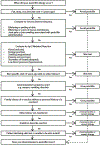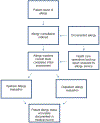Acute care beta-lactam allergy pathways: approaches and outcomes
- PMID: 31009700
- PMCID: PMC6637936
- DOI: 10.1016/j.anai.2019.04.009
Acute care beta-lactam allergy pathways: approaches and outcomes
Conflict of interest statement
Figures





References
-
- Zhou L, Dhopeshwarkar N, Blumenthal KG, et al. Drug allergies documented in electronic health records of a large healthcare system. Allergy. 2016;71(9):1305–1313. - PubMed
-
- Picard M, Begin P, Bouchard H, et al. Treatment of patients with a history of penicillin allergy in a large tertirary care academic hospital. J Allergy Clin Immunol Pract. 2013;1(3):252–257. - PubMed
-
- Lee CE, Zembower TR, Fotis MA, et al. The incidence of antimicrobial allergies in hospitalized patients: implication regarding prescribing patterns and emerging bacterial resistance. Arch Intern Med. 2000;160:2819–2822. - PubMed
-
- Sacco KA, Bates A, Brigham TJ, Imam JS, Burton MC. Clinical outcomes following inpatient penicillin allergy testing: A systematic review and meta-analysis. Allergy. 2017;72(9):1288–96. - PubMed
Publication types
MeSH terms
Substances
Grants and funding
LinkOut - more resources
Full Text Sources
Medical

